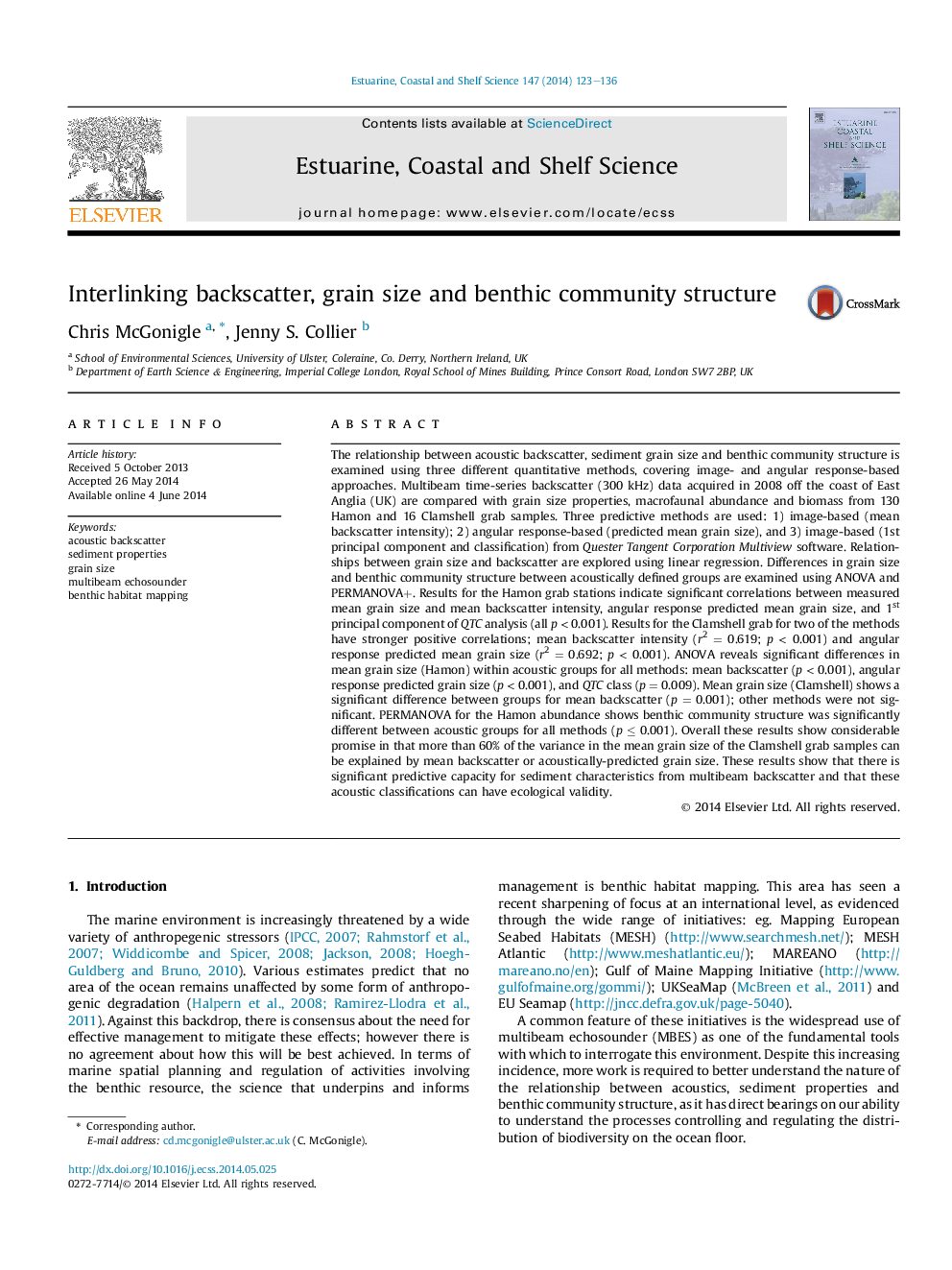| کد مقاله | کد نشریه | سال انتشار | مقاله انگلیسی | نسخه تمام متن |
|---|---|---|---|---|
| 6384944 | 1626649 | 2014 | 14 صفحه PDF | دانلود رایگان |
- Exploration of relationships between acoustic backscatter and sediment properties.
- Statistical examination of benthic community structure within acoustic classes.
- Significant differences in sediment grain size between objective acoustic classes.
- Significant differences in benthic community between objective acoustic classes.
- Demonstration of abiotic and biotic predictive capacity for acoustic backscatter.
The relationship between acoustic backscatter, sediment grain size and benthic community structure is examined using three different quantitative methods, covering image- and angular response-based approaches. Multibeam time-series backscatter (300 kHz) data acquired in 2008 off the coast of East Anglia (UK) are compared with grain size properties, macrofaunal abundance and biomass from 130 Hamon and 16 Clamshell grab samples. Three predictive methods are used: 1) image-based (mean backscatter intensity); 2) angular response-based (predicted mean grain size), and 3) image-based (1st principal component and classification) from Quester Tangent Corporation Multiview software. Relationships between grain size and backscatter are explored using linear regression. Differences in grain size and benthic community structure between acoustically defined groups are examined using ANOVA and PERMANOVA+. Results for the Hamon grab stations indicate significant correlations between measured mean grain size and mean backscatter intensity, angular response predicted mean grain size, and 1st principal component of QTC analysis (all p < 0.001). Results for the Clamshell grab for two of the methods have stronger positive correlations; mean backscatter intensity (r2 = 0.619; p < 0.001) and angular response predicted mean grain size (r2 = 0.692; p < 0.001). ANOVA reveals significant differences in mean grain size (Hamon) within acoustic groups for all methods: mean backscatter (p < 0.001), angular response predicted grain size (p < 0.001), and QTC class (p = 0.009). Mean grain size (Clamshell) shows a significant difference between groups for mean backscatter (p = 0.001); other methods were not significant. PERMANOVA for the Hamon abundance shows benthic community structure was significantly different between acoustic groups for all methods (p â¤Â 0.001). Overall these results show considerable promise in that more than 60% of the variance in the mean grain size of the Clamshell grab samples can be explained by mean backscatter or acoustically-predicted grain size. These results show that there is significant predictive capacity for sediment characteristics from multibeam backscatter and that these acoustic classifications can have ecological validity.
Graphical illustration of the ability of acoustic backscatter data analysed by two different methods to discriminate between contrasting sediment types within the study area. Results are shown for four Clamshell grab samples that represent the full range of sediment variability found. Sample number is indicated at the top of frame, geographic locations are indicated on Fig. 1. The bounding box of each sample is colour coded for ease of comparison. Each panel shows: Top row: Sediment sample parameters. (a) grain size distribution curve of material from the sample (Ф) and (b) summary grain size parameters. Middle row: Acoustic image analysis results. (c) histogram of backscatter intensity within analysis window (x¯BS1) shown in (d). Low intensity pixels have dark shades. Bottom row: Acoustic angular-range analysis results. (e) predicted mean sediment grain size based on angular response curve (FM-ARA1) in Ф. Note how as the sediments become coarser from top left to bottom right, the backscatter intensity increases and the angular response becomes flatter.252
Journal: Estuarine, Coastal and Shelf Science - Volume 147, 20 June 2014, Pages 123-136
